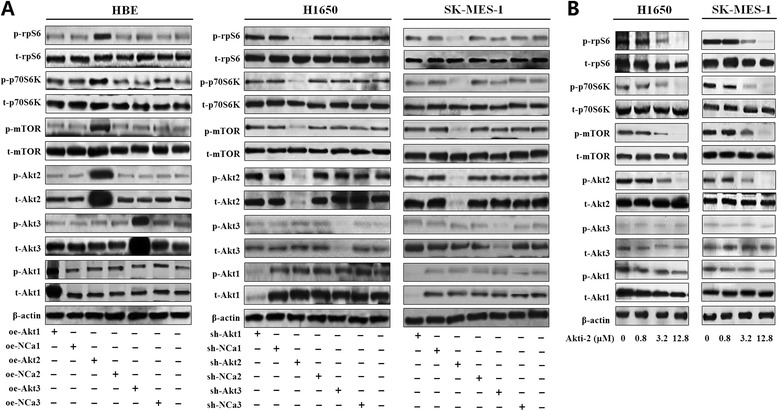Fig. 5.

The upstream regulation signaling pathway of rpS6. a Separate overexpression of Akt1, Akt2 and Akt3 in HBE cells showed that only Akt2 (oe-Akt2) led to marked hyperphosphorylation of mTOR, p70S6K and rpS6 (left; All P < 0.05); while Akt1 or Akt3 alteration resulted in no detectable change of these proteins (left; All P > 0.05). In H1650 and SK-MES-1 cell lines, only the specific silence of Akt2 (sh-Akt2) caused significant loss of p-mTOR, p-p70S6K and p-rpS6 (middle and right; All P < 0.05), and no notable alteration with the Akt1 and Akt3 knockdown were found (sh-Akt1, sh-Akt3; middle and right; All P < 0.05). b H1650 and SK-MES-1 were treated with Akti-2 (Akt inhibitor XII) for 72 h in concentration of 0.8, 3.2 and 12.8 μM. Western blot assays revealed the strongest effect of 12.8 μM and the accompanied dephosphorylation of mTOR, p70S6K and rpS6 (All P < 0.05). oe-Akt1: overexpression of Akt1; oe-NCa1: negative control for oe-Akt1; oe-Akt2: overexpression of oe-Akt2; oe-NCa2: negative control for oe-Akt2; oe-Akt3: overexpression of oe-Akt3; oe-NCa3: negative control for oe-Akt3. sh-Akt1: knockdown for Akt1; sh-NCa1: negative control for sh-Akt1; sh-Akt2: knockdown for Akt2; sh-NCa2: negative control for sh-Akt2; sh-Akt3: knockdown for Akt3; sh-NCa3: negative control for sh-Akt3
